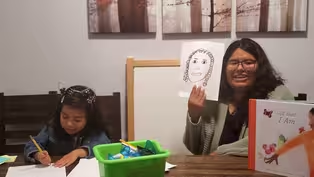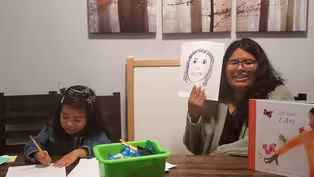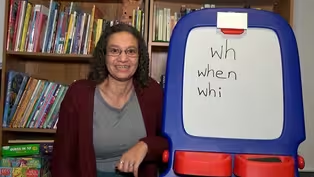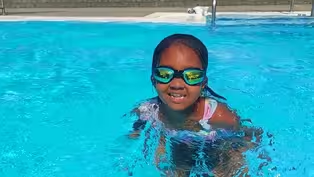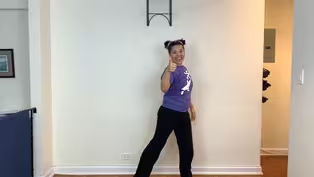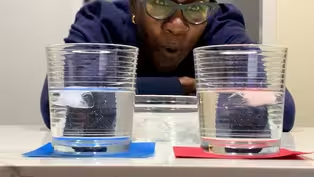
WATERCOLOR PAINTING
Clip: 4/15/2023 | 9m 1sVideo has Closed Captions
Lia Zuvilivia from Studio in a School guides students painting with watercolors.
Lia Zuvilivia from Studio in a School guides students painting with watercolors. They experiment with mixing colors and making colors lighter and darker.
Problems playing video? | Closed Captioning Feedback
Problems playing video? | Closed Captioning Feedback
Let's Learn is a local public television program presented by THIRTEEN PBS

WATERCOLOR PAINTING
Clip: 4/15/2023 | 9m 1sVideo has Closed Captions
Lia Zuvilivia from Studio in a School guides students painting with watercolors. They experiment with mixing colors and making colors lighter and darker.
Problems playing video? | Closed Captioning Feedback
How to Watch Let's Learn
Let's Learn is available to stream on pbs.org and the free PBS App, available on iPhone, Apple TV, Android TV, Android smartphones, Amazon Fire TV, Amazon Fire Tablet, Roku, Samsung Smart TV, and Vizio.
Providing Support for PBS.org
Learn Moreabout PBS online sponsorship[upbeat music] - Hello everyone.
- Hello.
- Hello.
- Today we are gonna make a watercolor paint.
We are going to use watercolors.
Let's see what we have today to paint.
- Yes.
- We have a.
- Paper?
- Paper.
- And we have a set of watercolors.
- Water.
- Water.
- Let's see what I have inside.
- A brush.
- Same brush.
- A paint.
- Let's take a look at the set.
What did you notice?
- I can see yellow.
- You see colors.
But look, we can't get messy 'cause they're not watered yet.
Water colors, they need water to make them work.
And the paint are dry.
So we need to wake up the color of the making water.
We have to get the paint brush to put the water.
- Exactly, good idea.
So now I'm going to leave the paintbrush on the water.
Did you hear the sound?
And now I need to wake up the colors.
I'm going to drop some on the paint.
Wiggly, wiggly.
Can I add more?
- Yeah.
[upbeat music] - I think I'm ready for blue.
Should I put some in the paper?
- Yeah.
- Let's try it.
- Wow.
- Do you like this blue?
- Yes.
- I'm going to have some more.
[upbeat music] Let's see what happen if I add water to the blue.
Let's see what happen.
What do you think is gonna happen?
- It's changing color.
- It turn into light blue.
The water make the colors light there.
Wow.
Can I put more?
- Yeah.
- Wow.
Look, it's getting lighter and lighter.
- Lighter and lighter.
- So if the water make it lighter, I wonder how I can make a dark blue.
- Like lots of lots of blue.
- Make it dark.
- That's a good idea.
Put more blue and less water, right?
- Yeah.
- Yeah.
- So I'm going to just wiggly, wiggly.
You were right.
Look how dark it is.
Wow.
So the water makes the colors lighter.
Do you think that I can keep painting?
Can I keep without adding paint or water?
- Yeah.
- Look what is happening.
[upbeat music] This is called dry brush.
Look it keep painting.
Now I'm going to rinse my brush and we were trying to paint on the dry paper.
- Yes.
- Can we paint on wet paper?
- No.
- No?
- Yes.
- Yes.
Thank you.
I'm going to paint just with water and see what happened.
I'm going to lot of water and now I'm going to add paint on top of the white paint pen.
Let's see what happens.
Are you ready?
- Yeah.
- Look.
How is this craving?
Now let me raise the paintbrush because now I want to mix some color.
Can I mix some colors?
- Yes.
- I'm going to pick yellow, so I need to wake him up.
- Wake up, wake up yellow.
Wake up, wake up.
- Wake up.
Wake up.
- I think it's ready.
I'm going to paint some yellow in here.
And can I yell it to the blue?
- Yeah.
- What is gonna happen?
- I don't know.
- I don't know.
- It's turning green.
- It's turning green.
- I like green.
- You like green?
Me too.
Should we add more water to make it like it?
- Yes.
- Yes.
Let's add more water then.
- Wow.
- It's getting lighter.
I think it's your turn.
Do you want to make your own cold water color?
- I do it too.
- Remember, you need to clean the paintbrush every time that you pick another color.
- We got, I got.
- We got green.
Wake up, yellow, wake up.
- Nice.
Be nicely.
They're waking up nicely.
- Green.
- Look at those colors.
- Is all yellow.
Look at my gray.
Wake up.
- You're spraying the green.
Orange.
- Orange, orange.
- Wake up, wake up, wake up, wake up.
[upbeat music] - And what happened if you keep adding water to the rest.
- I'm gonna make a multicolor.
- Multi.
That means a lot.
- Yeah.
So I'm gonna add a little bit of balloon.
- Wow, this is like a silver.
- I think I'm gonna use some of this water instead of the color.
I like that orange.
[upbeat music] I'm doing some yellow.
- I'm doing some squeaky yellow.
We're gonna use you now.
- Wakey, wakey.
- Why he saying wakey, wakey?
- Because I need to wake up my yellow.
It's green yellow.
- Why.
- I've got green inside the yellow.
- Oh.
[upbeat music] - It's a spray?
- Water.
- It's really fun.
- Wakey wakey blue.
Wakey wakey I wanna see you.
[upbeat music] - That's really dark blue.
I like the leather [indistinct].
- You like the wet on wet?
- Yeah.
[upbeat music] - Wow.
It's a yellow orange.
It's not pink anymore.
It's orange now.
- Rinse our paint brush nicely.
Now we're gonna close the step because we are done with the painting.
Now Ava, you put a lot of colors in your painting.
- I like it.
Ava.
- Which one is your favorite part of your painting?
- I like and I like bread and I like orange.
- Can you tell me how you made those bread dots soft spreading out.
- Use the water and I use the piece to spread it out.
- Fantastic.
Jay, what is your favorite part of the painting?
- I mix all the color with green and they made a multicolor.
I had some blue on the side and the rest was multicolor in the middle.
- Do you remember what color you put first?
- First I put is red.
Then I put a orange.
Then I put this color inside and then it's a little bit red up here, but it's orange in there.
- Fantastic.
You made a multicolor painting.
Now show me that you are baking.
You made some new colors.
- And he makes black and brown then makes it makes blue.
If he makes this, it makes pink.
- And you have a brown all around, but you didn't start with brown.
Which color did you put first?
- Red.
- Red, you did amazing.
Thumbs up everybody.
[pupils claps] Thank you guys.
You're really good.
Now is your turn to make your own watercolor painting.
How you gonna use the water to make your color lighter or darker?
Are you gonna mix the color or using wet on wet?
It's really fun.
Have fun artist.
Video has Audio Description, Closed Captions
Clip: 6/12/2023 | 9m 42s | Katherine Rodriguez reads ALL THAT I AM by M.H. Clark, illustrated by Laura Carlin. (9m 42s)
Video has Closed Captions
Clip: 4/15/2023 | 9m 42s | Katherine Rodriguez reads ALL THAT I AM by M.H. Clark, illustrated by Laura Carlin. (9m 42s)
Video has Closed Captions
Clip: 4/15/2023 | 12m 12s | Anna Scretching-Cole teaches about the diagraphs th and wh. (12m 12s)
Video has Closed Captions
Clip: 4/15/2023 | 48s | Jordyn and Jada go swimming. (48s)
Video has Closed Captions
Clip: 4/15/2023 | 8m 50s | Cassondra Easterling simulates the sound rain makes on different surfaces. (8m 50s)
Video has Closed Captions
Clip: 4/15/2023 | 6m 50s | Jessi Colon from National Dance Institute performs a dance inspired by the Nile River. (6m 50s)
Video has Closed Captions
Clip: 4/15/2023 | 6m 19s | Eve Townsend compares the amount of water different containers can hold. (6m 19s)
Providing Support for PBS.org
Learn Moreabout PBS online sponsorshipSupport for PBS provided by:
Let's Learn is a local public television program presented by THIRTEEN PBS
